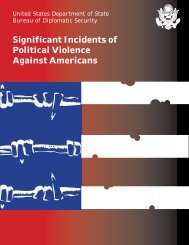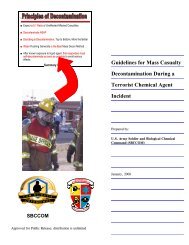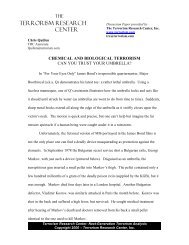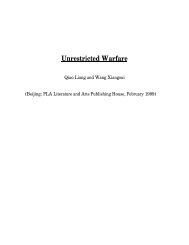Combating Proliferation of Weapons of Mass Destruction
Combating Proliferation of Weapons of Mass Destruction
Combating Proliferation of Weapons of Mass Destruction
Create successful ePaper yourself
Turn your PDF publications into a flip-book with our unique Google optimized e-Paper software.
narcotics. When AES matches shipments against these rules, the shipments are assigneda score based on weight associated with the rules. Inspectors can search throughshipments and see the scores automatically assigned by ATS-AT.In addition, ATS-AT allows inspectors and other law-enforcement <strong>of</strong>ficials to enter searchcriteria that can be matched to outbound shipments. For example, an agent could input thename <strong>of</strong> a foreign party that investigative or intelligence information has identified as a frontcompany for a proliferation end user. The agent could also enter the likely port <strong>of</strong> exportand the value, weight and description <strong>of</strong> a shipment, if known. If shipments addressed tothat foreign party were filed through the AES, the shipments would be flagged. Lawenforcement would then have the opportunity to hold and examine the flagged shipments,thus facilitating interdiction.The information collected by AES would be particularly useful in analyzing the acquisitionmethods and networks <strong>of</strong> proliferators. If <strong>of</strong>ficials noted the export <strong>of</strong> a combination <strong>of</strong>WMD-related items to a particular country <strong>of</strong> concern, that knowledge would be useful insupporting either counter-proliferation efforts or diplomatic efforts with that country. Suchinformation would also provide information about the degree <strong>of</strong> development <strong>of</strong> a country’sWMD programs.Customs does not require exporters to use AES, and participation levels remain extremelylow. With the significant technological advances that have been made since 1995, it isappropriate now to begin phasing in mandatory participation in AES. There is an initial costto businesses to develop or obtain AES s<strong>of</strong>tware or to contract with a service to file viaAES. If there is concern about the burden mandatory participation would have on smallbusiness, however, it might be more appropriate to create an exemption for suchbusinesses than to define the entire process around their concerns. In addition, someresistance to participation in AES is based on a long-standing situation in which exportershave been allowed to file on a post-departure basis, either on a de facto basis becausecarriers can file up to four days after departure, or through the AERP, the CommerceDepartment’s monthly electronic SED filing program, which is set to expire on December31, 1999. Therefore, there is currently little or no incentive to participate in AES.Only about 30,000 exports per month are processed through AES and the program isbasically funded for the current level <strong>of</strong> participation. Beginning in fiscal year 1999, theCustoms Service has a separate line-item appropriation for AES. Customs is expectingmany <strong>of</strong> the participants in the Department <strong>of</strong> Commerce’s electronic filing program toconvert to AES when the Commerce program expires. Significantly higher participationrates will tax the AES system, which suffers from occasional hardware problems even atits current low level <strong>of</strong> participation. However, as participation in AES increases, there willbe a corresponding decrease in the data entry burden for the Bureau <strong>of</strong> Census, whichnow manually enters information from 500,000 paper SEDs into the Foreign TradeStatistics database each month in addition to electronic filings.90







